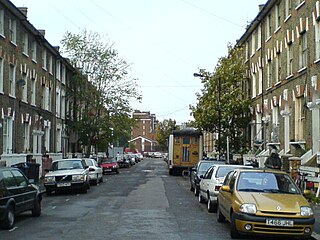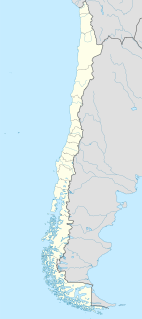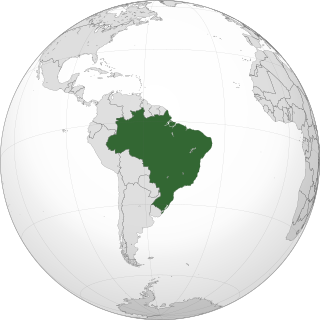
Squatting is the action of occupying an abandoned or unoccupied area of land or a building, usually residential, that the squatter does not own, rent or otherwise have lawful permission to use. The United Nations estimated in 2003 that there were one billion slum residents and squatters globally. Squatting occurs worldwide and tends to occur when people who are poor and homeless find empty buildings or land to occupy for housing. It has a long history, broken down by country below.

St Agnes Place was a squatted street in Kennington, south London, which resisted eviction orders for more than 30 years. When a number of derelict houses were scheduled for demolition to extend Kennington Park in 1969, squatters occupied the properties and a High Court injunction prevented the demolition. The street was run by a housing cooperative until 2005, when Lambeth London Borough Council obtained an eviction order. Demolition was completed in 2007.
London Street Commune was a hippy movement formed during the 1960s. It aimed to highlight concerns about rising levels of homelessness and to house the hundreds of hippies sleeping in parks and derelict buildings in central London.
Jack Tafari was a sometimes homeless Rastafari activist who advocated for himself and other homeless people, in the US and the UK. He was best known for promoting "sanctioned tent cities" as transitional housing for homeless people, including himself, in Portland, Oregon, United States.
Dos Blockos was a squat situated at 713 East 9th Street in Alphabet City, Manhattan, New York City. In active use as a squat from 1992 onwards, the six-story building housed up to 60 people at its peak, including Brad Will. The building funded repairs by being a set for movies including Trainspotting. The squatters were evicted in 1999 and the building was converted into a commercial apartment building.
The Frances Street Squats were a set of six squatted houses, including one women-only building, that existed between February and November 1990 in Vancouver, Canada. They were occupied by SAVE and took a stand against development which was generally supported by local people. The Vancouver Police Department evicted the buildings.
Take Back the Land is an American organization based in Miami, Florida, devoted to blocking evictions, and rehousing homeless people in foreclosed houses. Take Back the Land was formed in October 2006 to build the Umoja Village shantytown on a plot of unoccupied land to protest gentrification and a lack of low-income housing in Miami. The group began opening houses in October 2007 and moved six homeless families into vacant homes in 2008. By April 2009, the group had moved 20 families into foreclosed houses. As of November 2008, the group had ten volunteers. Take Back the Land volunteers break into the houses, clean, paint, and make repairs, change the locks, and help move the homeless families in. They provide supplies and furniture and help residents turn on electricity and water. Though the occupations are of contested legality, as of December 2008 local police officers were not intervening, judging it to be the responsibility of house owners to protect their property or request assistance.

In England and Wales, squatting—taking possession of land or an empty house the squatter does not own—occurs for a variety of reasons which include needing a home, protest, poverty, and recreation. Many squats are residential; some are also opened as social centres. Land may be occupied by New Age travellers or treesitters.
Squatting in the United States is the unauthorized use of real estate. Historically, squatting occurred during the California Gold Rush and when colonial European settlers established land rights. There was squatting during the Great Depression in Hoovervilles and also during World War II. Shanty towns returned to the US after the Great Recession of 2007 to 2009 and in the 2010s, there have been increasing numbers of people squatting foreclosed homes using fraudulent documents. In some cases, a squatter may be able to obtain ownership of property through adverse possession.

Focus E15 is a campaign group formed in London in 2013 by a group of mothers threatened with eviction from their emergency accommodation in a hostel for young homeless people in Newham. The group squatted empty flats on the Carpenters Estate in Stratford in September 2014, drawing widespread attention in the mainstream media. Most of the young women were rehoused within the borough as they had requested and having won their own battle, they have continued to protest both against the local housing policy of Newham Council and for housing rights more generally. They have done so by occupying various buildings and supporting different individual struggles.
Squatters' Action for Secure Homes (SQUASH) is an activist group formed first in the 1990s in the United Kingdom to represent the interests of squatters and to fight the proposed criminalisation of squatting. It then reformed in 2011, when there were again parliamentary discussions about making squatting illegal. After squatting was (partially) criminalised in 2012, the group continues to monitor arrests and convictions.

Squatting in Australia usually refers to a person who is not the owner, taking possession of land or an empty house. In 19th century Australian history, a squatter was a settler who occupied a large tract of Aboriginal land in order to graze livestock. At first this was done illegally, later under licence from the Crown.

Squatting in the Republic of Ireland is the occupation of unused land or derelict buildings without the permission of the owner. In the 1960s, the Dublin Housing Action Committee highlighted the housing crisis by squatting buildings. From the 1990s onwards there have been occasional political squats in Cork and Dublin such as Grangegorman, the Barricade Inn, the Bolt Hostel, Connolly Barracks, That Social Centre and James Connolly House.

Squatting in the Netherlands is the occupation of unused or derelict buildings or land without the permission of the owner. The modern squatters movement began in the 1960s in the Netherlands. By the 1980s, it had become a powerful anarchist social movement which regularly came into conflict with the state, particularly in Amsterdam with the Vondelstraat and coronation riots.

The battle of Mainzer Straße took place in Friedrichshain, East Berlin between 12 and 14 November 1990. It was a major incident in the history of the city, following the fall of the Berlin Wall in 1989. The magistrate of East Berlin decided to evict a row of squatted apartment blocks and the autonomous movement resisted the eviction for three days, until the buildings were all evicted by the police. One person was wounded by a ricochet and 417 people were arrested in an operation of over 3,000 officers. Following the riots, the magistrate decided to concentrate on legalizing squats in Berlin.

Squatting in Chile is the occupation of unused land or derelict buildings without the permission of the owner. From the 1960s onwards, informal settlements known as callampas were permitted although there were also evictions such as the massacre of Puerto Montt in 1969. In the 1970s, the government of Salvador Allende encouraged occupations, then following the coup d'état, the military junta repressed squatting. Callampas then became known as campamentos.

Squatting in Brazil is the occupation of unused or derelict buildings or land without the permission of the owner. After attempting to eradicate slums in the 1960s and 1970s, local governments transitioned to a policy of toleration. Cities such as Recife, Rio de Janeiro and São Paulo have large informal settlements known as favelas. A more recent phenomenon is the occupation of buildings in city centres by organised groups. In rural areas across the country, the Landless Workers' Movement (MST) arranges large land occupations.

Squatting in the Philippines occurs when people build makeshift houses called "barong-barong"; urban areas such as Metro Manila and Metro Davao have large informal settlements. The Philippine Statistics Authority has defined a squatter, or alternatively "informal dwellers", as "One who settles on the land of another without title or right or without the owner's consent whether in urban or rural areas". Squatting is criminalized by the Urban Development and Housing Act of 1992, also known as the Lina Law. There have been various attempts to regularize squatter settlements, such as the Zonal Improvement Program and the Community Mortgage Program. In 2018, the Philippine Statistics Authority estimated that out of the country's population of about 106 million, 4.5 million were homeless.

Squatting in Liberia is one of three ways to access land, the other being ownership by deed or customary ownership. West Point was founded in Monrovia in the 1950s and is estimated to house between 29,500 and 75,000 people. During the First Liberian Civil War 1989–1997 and the Second Liberian Civil War 1999–2003, many people in Liberia were displaced and some ended up squatting in Monrovia. The Ducor Hotel fell into disrepair and was squatted, before being evicted in 2007. Recently, over 9,000 Burkinabés were squatting on remote land and the Liberia Land Authority (LLA) has announced it will be titling all land in the country.

Following the 1962 coup d'état, Myanmar was ruled by a military dictatorship under which squatters were often evicted. In 2016, Aung San Suu Kyi led a civilian government and the first major eviction of squatters took place the following year at Hlegu Township, located northeast of Yangon; these squatters claimed they had bought their land legally.













